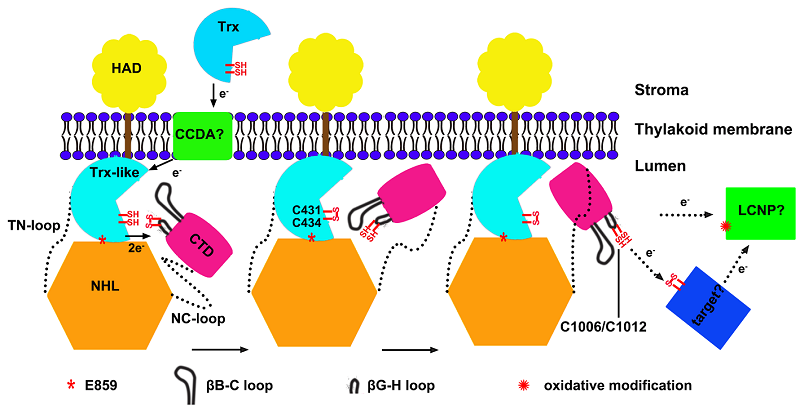Scientists reveal how the lumenal region of SOQ1 negatively regulates photoprotective qH in plants
To adapt to the constantly changing natural environment, plants have evolved various photoprotective mechanisms to avoid or reduce photo-oxidative damage, which called non-photochemical quenching (NPQ). In 2013, a new sustained NPQ form, termed qH, was discovered in Arabidopsis thaliana. The plastid lipocalin (LCNP) located at the thylakoid lumen is necessary for qH to turn on, while a thylakoid membrane-anchored protein, SUPPRESSOR OF QUENCHING 1 (SOQ1), negatively regulates qH through inhibiting LCNP.
SOQ1 is a membrane protein consisting of 1055 amino acid residues. Previous studies have found that the lumen-located thioredoxin-like (Trx-like) domain and β-propeller NHL domain are responsible for qH inhibition, while the stroma-located haloacid dehalogenase-like hydrolase (HAD) domain is not involved in qH regulation. Being a newly discovered protein that plays an important role in regulating NPQ, SOQ1 has drawn great attentions in the field of photosynthesis research.
Dr. LI Mei's group from the Institute of Biophysics (IBP), Chinese Academy of Sciences in collaboration with Dr. Alizee Malnoe' s group from Umea University, Sweden, have solved four crystal structures of the lumenal region of Arabidopsis SOQ1 (SOQ1-LD) in different truncated and mutated forms as well as a low-resolution cryo-EM structure of SOQ1-LD. The results showed that in addition to the three previously identified domains, the C-terminal 159 residues of SOQ1 form an independent domain, termed CTD, that plays an essential role in negatively regulating qH. Scientists have performed biochemical and in vivo functional experiments in addition to structural analysis, results together revealed the potential working model of SOQ1-LD inhibiting LCNP, thus providing a solid foundation for in-depth exploration of the regulatory mechanism of NPQ and qH.
The research work, entitled "Structure of Arabidopsis SOQ1 lumenal region unveils C-terminal domain essential for negative regulation of photoprotective qH", was published in Nature Plants on July 7, 2022. The project was funded by the National Key R&D Program of China, the Strategic Priority Research Program of CAS, National Natural Science Foundation of China.

Figure. 1. Proposed working model of SOQ1 in suppressing qH
Full text link: https://www.nature.com/articles/s41477-022-01177-z
Contact: LI Mei
Institute of Biophysics, Chinese Academy of Sciences
Beijing 100101, China
Email: meili@ibp.ac.cn
(Reported by Dr. LI Mei's group)

